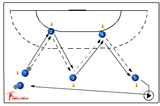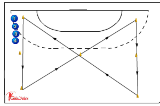Access Coaching session 1. Football (11/12/14)
Access Coaching session 2. Volleyball (13/11/14)
ADD PICS!
Access Coaching (football and volleyball) Self Evaluation of Session (13/11/14) & (11/12/14)
Session
plan:
Did you produce a lesson plan prior to the start of the
session? Yes/No
Was the session planned appropriately for the needs of the
participants? Yes/No
Was the session well sequenced: did activities link well from
one to the next? Yes/No
Did the session meet the objectives? Yes/No
Delivery:
Did you communicate effectively throughout the session? Yes/No
Give an example of when this happened or could have happened:
I used verbal communication well when I had to explain both the warm up and
main activity to the participants. However I feel that I could have further
improved my communication by also using hand gestures and giving a physical
demonstration to further the understanding of the participants and also give an
autonomous demonstration for the participants to copy.
Did you use the equipment and the environment effectively
throughout? Yes/No
Give an example of when this happened or could have happened:
I feel that we used the environment by using the lines of the basketball court
to give better guidelines during the second dribbling activity of where the
participants should and shouldn’t go to avoid injury from collisions.
Did you organise the session effectively? Yes/No
Give an example of when this happened or could have happened:
I don’t feel that the session was fully organised to the level it could have
been, for example we had to alter our time management and extend the main
game/activity to fill the full time of the session because the second dribbling
activity lead to tedium very quickly as it was far too simple.
Did you actively engage in the delivery as team member
throughout? Yes/No
Give an example of when this happened or could have happened:
yes I feel that I did this by giving the team members assigned positions within
each part of the session (e.g. I would be a motivator for one section and next
being the team member who explains the next section). This in effect meant that
all of the team members (including myself) were in some way engaged with each section
to be as an effective team members as possible.
Did you wear appropriate clothing for the session? Yes/No
Yes I wore the appropriate clothing for the section
(trainers, shorts and college shirt). This way I could become more effective in
the session like for example actually participating in the session and also to
demonstrate certain sections.
Did you motivate the participants and offer encouragement? Yes/No
Give an example of when this happened or could have happened:
Yes I feel as if I motivated the participants by providing verbal feedback
(mainly positive) to encourage them to keep going and achieve what each part of
the session was asking of them. An example included when I kept saying ‘keep
going’ to the access students to keep them motivated avoid tedium.
Did you demonstrate appropriate body language throughout? Yes/No
Give an example of when this happened or could have happened:
Yes I feel that for the majority of the session I did this by keeping my hands
out of my pockets and keeping my shoulders back to show that I was engaging
with my participants and interested in the session I was explaining.
Did you position yourself effectively during delivery? Yes/No
Give an example of when this happened or could have happened:
I feel that for the majority of the session I positioned myself correctly, for
example I tried to get my participants in front of me in a confined area so
that they wouldn’t get distracted and was able to see them all when explaining
something.
Did you position yourself effectively whilst supporting
delivery? Yes/No
Give an example of when this happened or could have happened:
I feel that I did not position myself effectively when supporting the
deliveries. E.g. I was often getting in the way of the participants during
other peoples sessions as I didn’t know how they were set out due to a lack of
organisation.
Key strengths demonstrated:
The key strengths I showed were; good communication with my
participants to make sure they both understood what to do and could answer and
queries they had, this way they will know what to do and it will avoid injury
or lack of improvement over time. I showed a good use of equipment for example
when we did not have the correct balls (footballs) we improvised and used soft
balls instead. I also felt that another of main strengths included my
encouragement, I did this in many forms such as positive verbal feedback,
clapping and even some constructive feedback for the individuals who were
looking to improve further. Lastly I felt main key strength was my positioning
during delivery, this is because I gave the participants a given area which
they had to sit in and this meant that they could not mess around as they were
all in my line of sight, which in effect meant that there was less
misunderstanding overall.
Areas for further development:
My weaknesses included; my organisation of the session
overall, but especially when for example things did not go as planned (the time
zone was not as long as expected for one of the sessions) this meant that as a
result the other sessions had to compensate and lead to some of the students
becoming bored and thus lost focused/messed around. Lastly, I felt that another
of my key weaknesses included my positioning when supporting the delivery.







